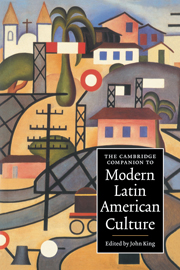Book contents
- Frontmatter
- Introduction
- 1 Pre-Columbian and colonial Latin America
- 2 Latin America since independence
- 3 Spanish American narrative, 1810-1920
- 4 Spanish American narrative, 1920-1970
- 5 Spanish American narrative since 1970
- 6 Brazilian narrative
- 7 Latin American poetry
- 8 Popular culture in Latin America
- 9 Art and architecture in Latin America
- 10 Tradition and transformation in Latin American music
- 11 The theatre space in Latin America
- 12 Cinema in Latin America
- 13 Hispanic USA
- Index
9 - Art and architecture in Latin America
Published online by Cambridge University Press: 28 May 2006
- Frontmatter
- Introduction
- 1 Pre-Columbian and colonial Latin America
- 2 Latin America since independence
- 3 Spanish American narrative, 1810-1920
- 4 Spanish American narrative, 1920-1970
- 5 Spanish American narrative since 1970
- 6 Brazilian narrative
- 7 Latin American poetry
- 8 Popular culture in Latin America
- 9 Art and architecture in Latin America
- 10 Tradition and transformation in Latin American music
- 11 The theatre space in Latin America
- 12 Cinema in Latin America
- 13 Hispanic USA
- Index
Summary
In the 1920s a group of Brazilian intellectuals produced an 'Anthropophagite Manifesto', arguing that they should devour the arts of Europe in order to nourish themselves and to produce a new Brazilian culture, vital and powerful. This image is a helpful way of articulating much of Latin American culture in the twentieth century, as artists and intellectuals have actively soughtways of affirming their strength and autonomy while still acknowledging Europe as an important source of ideas. The cannibal metaphor is also a useful way of approaching the art of earlier centuries: much of the best of colonial art and architecture is not a weak and belated echo of European innovations, as conventional notions of centre and periphery would have it, but a translation or transformation of imported ideas to suit a different context. This chapter will argue that the art and architecture of Latin America are interesting for their selective appropriations and manipulations, for their originality rather than for their dependence.
- Type
- Chapter
- Information
- The Cambridge Companion to Modern Latin American Culture , pp. 202 - 235Publisher: Cambridge University PressPrint publication year: 2004

